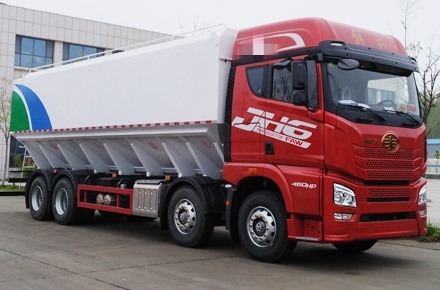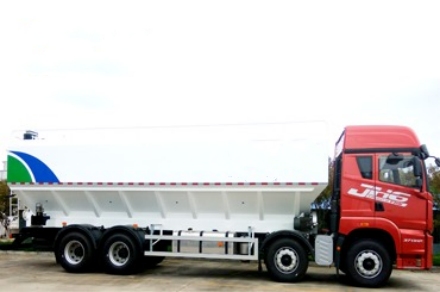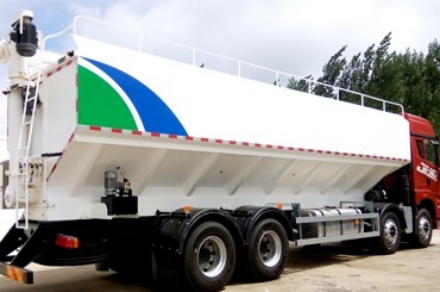Dry bulk trailers are specialized vehicles designed for the transportation of dry bulk materials such as cement, flour, grain, sand, and other fine particles. These trailers are a critical component of various industries, including construction, agriculture, and food processing. Understanding how dry bulk trailers work involves examining their design, loading and unloading mechanisms, operational principles, and maintenance requirements.
Design and Components of Dry Bulk Trailers
Dry bulk trailers, also known as pneumatic trailers, are designed to carry large volumes of powdered or granular materials. They typically feature the following key components:
- Tank Structure – The main body of the dry bulk trailer is a cylindrical or conical tank made of aluminum or steel. The tank is designed to handle pressurized unloading and to minimize residue retention.
- Manholes – These are located on top of the trailer and provide access for loading materials. They are sealed tightly to prevent contamination and leakage.
- Aeration System – Dry bulk trailers use aeration pads or cones that introduce air into the tank to fluidize the material, making it easier to unload.
- Piping and Valves – The trailer is equipped with pipelines and valves that control the flow of materials during unloading.
- Blower System – The most critical component of the unloading process, the blower generates compressed air that assists in moving the materials out of the tank.
- Discharge Outlet – This is the exit point for the material, located at the bottom of the trailer.

How Loading Works in Dry Bulk Trailers
The loading process of a dry bulk trailer can be done in several ways, depending on the material type and industry standards:
- Gravity Loading – Materials are loaded into the trailer through the top manholes using gravity from overhead storage silos or conveyors.
- Vacuum Loading – Some trailers are equipped with a vacuum system that sucks materials from storage bins into the tank.
- Pneumatic Conveyance – Certain materials, like cement and flour, can be blown into the trailer using compressed air systems.
Once the material is inside, the manholes are tightly sealed to ensure that no dust escapes and the load remains intact during transportation.
How Unloading Works in Dry Bulk Trailers
The unloading process is where dry bulk trailers show their efficiency and specialization. Since these trailers transport fine powders and granules, they require specialized unloading systems:
- Pneumatic Unloading – Compressed air is introduced into the tank to fluidize the material. This turns the dry bulk product into a semi-fluid state, making it easier to move.
- Aeration Pads and Cones – These features help maintain consistent air distribution, preventing clogging and ensuring a smooth flow of materials toward the discharge outlet.
- Blower System Operation – The blower generates air pressure that pushes the fluidized material out through the piping system to the receiving silo, truck, or storage facility.
- Controlled Flow Rate – Operators control the unloading speed by adjusting the valves and air pressure settings to prevent clogging and ensure efficient delivery.

Types of Dry Bulk Trailers
Dry bulk trailers come in different designs to suit various transportation needs. The three main types include:
- Vacuum Pneumatic Dry Bulk Trailers – These use vacuum suction for loading and compressed air for unloading. Ideal for fine powders like flour and cement.
- Gravity Drop Dry Bulk Trailers – These rely on gravity to unload material, making them suitable for grains and pellets.
- Pressurized Dry Bulk Trailers – These trailers are designed for high-pressure unloading, making them ideal for dense materials such as sand and lime.
Industries That Use Dry Bulk Trailers
Dry bulk trailers are essential in multiple industries, including:
- Construction – Transporting cement, fly ash, and sand for concrete production.
- Agriculture – Carrying grains, fertilizers, and animal feed.
- Food Processing – Transporting flour, sugar, and starch.
- Chemical Industry – Moving powdered chemicals and plastic resins.

Maintenance and Safety of Dry Bulk Trailers
To ensure the longevity and efficiency of a dry bulk trailer, proper maintenance is crucial:
- Routine Inspections – Check aeration systems, valves, blowers, and piping for wear and tear.
- Cleaning Procedures – Regular interior and exterior cleaning prevents material contamination and buildup.
- Blower System Checks – Ensure the blower is functioning properly to maintain unloading efficiency.
- Seal and Gasket Maintenance – Check manhole seals and outlet gaskets to prevent leaks and ensure safe transportation.
- Pressure Testing – Regularly test the tank’s pressure system to ensure safe pneumatic unloading.
Conclusion
Dry bulk trailers play a vital role in transporting fine and granular materials across various industries. Their efficient design, coupled with advanced pneumatic unloading systems, makes them indispensable for businesses that require bulk material handling. Understanding their operation, maintenance, and safety protocols ensures optimal performance and longevity, making them a reliable choice for bulk material transportation.


